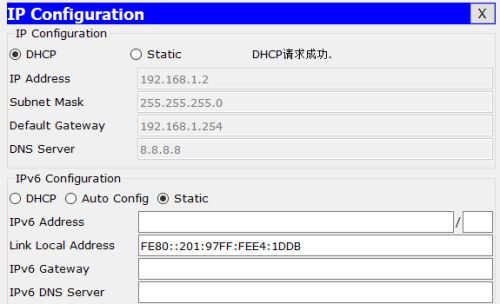Dhcp Failed Apipa Is Being Used
DHCP is based on BOOTP which was created in 1985. BOOTP uses TFTP as the file transfer protocol. TFTP was created in 1981 and uses port 69, so it was a thing of using the nearest non-used ports (68 and 67). Jun 13, 2019 Automatic Private IP Addressing (APIPA) is a DHCP fail-safe that protects a computer system from failure by invoking a standby mechanism for local Internet Protocol version 4 (IPv4) networks supported by Microsoft Windows. With APIPA, DHCP clients can obtain IP addresses even when DHCP servers are not functional.
Automatic Private IP Addressing (APIPA) is a network client-side process used as a fallback position when DHCP services are not available on the network but the client devices are configured to use DHCP for their IP address configuration.

APIPA allows the client device to randomly choose one of the 65,534 addresses available in the Class B network address of 169.254.0.0/16. After choosing an address from this range, the computer sends an ARP request to see whether another device on the network is using that address, and if it is not, the client device uses the address.
APIPA is being used. The command to be used under each interface is switchport mode trunk. Regards Aref.
Even though the device uses this made-up address, it continues to send out DHCP Discover broadcasts to locate a DHCP server on the network as soon as the DHCP server becomes available.


While waiting for a valid DHCP-delivered address, the device that is using an APIPA address can communicate with any other device on the network that is using an APIPA address.
If two or more devices are connected to a switch and the devices are using APIPA, therefore, all of them can communicate at least with each other, but not with any other devices on the network that are using proper addresses for that network segment.
DHCP (Dynamic Host Configuration Protocol) is a protocol used to provide quick, automatic, and central management for the distribution of IP addresses within a network.
DHCP is also used to configure the proper subnet mask, default gateway, and DNS server information on the device.
How DHCP Works
A DHCP server is used to issue unique IP addresses and automatically configure other network information. In most homes and small businesses, the router acts as the DHCP server. In large networks, a single computer might act as the DHCP server.
In short, the process goes like this: A device (the client) requests an IP address from a router (the host), after which the host assigns an available IP address to allow the client to communicate on the network. A bit more detail below...
Once a device is turned on and connected to a network that has a DHCP server, it will send a request to the server, called a DHCPDISCOVER request.
After the DISCOVER packet reaches the DHCP server, the server attempts to hold on to an IP address that the device can use, and then offers the client the address with a DHCPOFFER packet.
Once the offer has been made for the chosen IP address, the device responds to the DHCP server with a DHCPREQUEST packet to accept it, after which the server sends an ACK that's used to confirm that the device has that specific IP address and to define the amount of time that the device can use the address before getting a new one.
If the server decides that the device cannot have the IP address, it will send a NACK.
All of this, of course, happens very quickly and you don't need to know any of the technical details you just read in order to get an IP address from a DHCP server.
An even more detailed look at the different packets involved in this process can be read on Microsoft's DHCP Basics page.
Pros and Cons of Using DHCP
A computer, or any other device that connects to a network (local or internet), must be properly configured to communicate on that network. Since DHCP allows that configuration to happen automatically, it's used in almost every device that connects to a network including computers, switches, smartphones, gaming consoles, etc.
Because of this dynamic IP address assignment, there's less of a chance that two devices will have the same IP address, which is very easy to run into when using manually-assigned, static IP addresses.
Using DHCP also makes a network much easier to manage. From an administrative point of view, every device on the network can get an IP address with nothing more than their default network settings, which is set up to obtain an address automatically. The only other alternative is to manually assign addresses to each and every device on the network.
Because these devices can get an IP address automatically, they can move freely from one network to another (given that they're all set up with DHCP) and receive an IP address automatically, which is super helpful with mobile devices.
In most cases, when a device has an IP address assigned by a DHCP server, that IP address will change each time the device joins the network. If IP addresses are assigned manually, it means administration must not only give out a specific address to each new client, but existing addresses that are already assigned must be manually unassigned for any other device to use that same address. This is not only time-consuming, but manually configuring each device also increases the chance of running into human-made errors.
Though there are plenty of advantages to using DHCP, there are certainly some disadvantages as well. Dynamic, changing IP addresses should not be used for devices that are stationary and need constant access, like printers and file servers.
Although devices like that exist predominantly in office environments, it's impractical to assign them with an ever-changing IP address. For example, if a network printer has an IP address that will change at some point in the future, then every computer that's connected to that printer will have to regularly update their settings so their computers will understand how to contact the printer.
This type of setup is extremely unnecessary and can be easily avoided by not using DHCP for those types of devices, and instead by assigning a static IP address to them.
The same idea comes into play if you need to have permanent remote access to a computer in your home network. If DHCP is enabled, that computer will get a new IP address at some point, which means the one you've recorded as that computer having, will not be accurate for long. If you're using remote access software that relies on a IP address-based access, you'll need to use a static IP address for that device.
More Information On DHCP
A DHCP server defines a scope, or range, of IP addresses that it uses to serve devices with an address. This pool of addresses is the only way a device can obtain a valid network connection.
This is another reason DHCP is so useful - because it allows lots of devices to connect to a network over a period of time without needing a massive pool of available addresses. For example, even if only 20 addresses are defined by the DHCP server, 30, 50, or even 200 (or more) devices can connect to the network so long as no more than 20 are using one of the available IP address simultaneously.
Because DHCP assigns IP addresses for a specific period of time (a lease period), using commands like ipconfig to find your computer's IP address will yield different results over time.
Though DHCP is used to deliver dynamic IP addresses to its clients, it doesn't mean static IP addresses can't also be used at the same time. A mixture of devices that are getting dynamic addresses and devices that have their IP addresses manually assigned to them, can both exist on the same network.
Dhcp Failed Apipa Is Being Used Solusi
Even an ISP uses DHCP to assign IP addresses. This can be seen when identifying your public IP address. It will likely change over time unless your home network has a static IP address, which is usually only the case for businesses that have publicly accessible web services.
Apipa Ip Range
In Windows, APIPA assigns a special temporary IP address when the DHCP server fails to deliver a functional one to a device, and uses this address until it can obtain one that works.
How To Disable Apipa
The Dynamic Host Configuration Working Group of the Internet Engineering Task Force created DHCP.